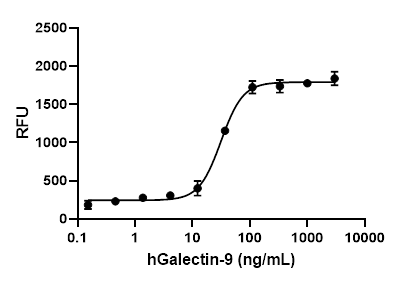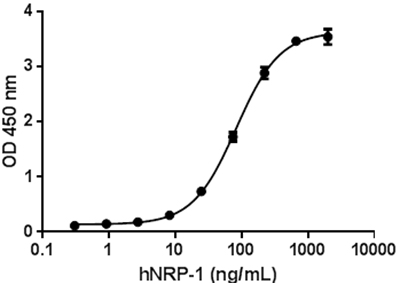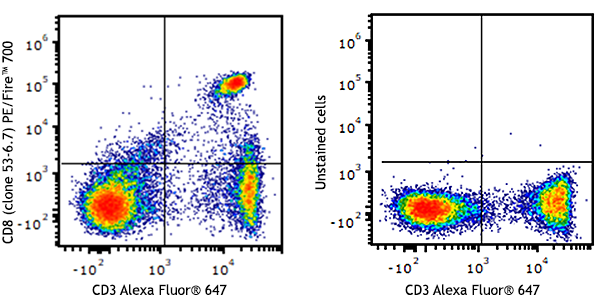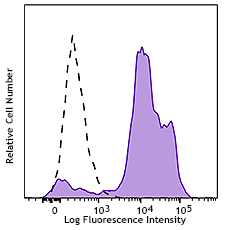- Regulatory Status
- RUO
- Other Names
- Lectin, Galactoside-Binding, Soluble, 3 (LGALS3), L31, GAL3, MAC2, Carbohydrate-Binding Protein 35 (CBP35), Galactose Binding Protein (GALBP), GALIG, Galactose-Specific Lectin 3
- Ave. Rating
- Submit a Review
- Product Citations
- publications
| Cat # | Size | Price | Quantity Check Availability | Save | ||
|---|---|---|---|---|---|---|
| 774402 | 10 µg | 83 CHF | ||||
| 774404 | 25 µg | 136 CHF | ||||
| 774406 | 100 µg | 335 CHF | ||||
| 774408 | 500 µg | 968 CHF | ||||
Galectin-3 is a member of the lectin family which includes 15 mammalian lectin members. Like all galectins, Galectin-3 contains a carbohydrate recognition binding domain of about 130 amino acids that enables the specific binding of β-galactosides. This protein has been shown to be involved in the cell adhesion, cell activation and chemoattraction, cell growth and differentiation, cell cycle, and apoptosis. Galectin-3 induces pro-inflammatory cytokines and inhibits Th2 type cytokine production. It chemoattracts monocytes and macrophages, and activates and degranulates basophils and mast cells. It was reported that Galectin-3 knock-out mice demonstrated reduced phagocytic properties in macrophages and Kupffer cells, indicating that this protein is involved in macrophage phagocytosis. Recently, Galectin-3 has been shown to be involved in cancer, inflammation, and fibrosis, heart disease, and stroke. It has also shown that the expression of galectin-3 is implicated in a variety of processes associated with heart failure, including myofibroblast proliferation, tissue repair, inflammation, fibrogenesis, and ventricular remodeling. In addition, Galectin-3 was found to contribute to the tumor cell evasion of the immune system. Galectin-3 is increasingly being used as a diagnostic marker for different cancers. It can be screened for and used as a prognostic factor to predict the progression of the cancer. Overexpression of Galectin-3 is associated with neoplastic transformation, enhancement of tumor cell adhesion to the extracellular matirx, and the subsequent metastatic spreading of the cancer cells.
Product DetailsProduct Details
- Source
- Human Galectin 3 amino acids (Ala2-Ile250) (Accession # NP_002297.2) was expressed in E. coli. The amino terminus contains MGSS6HSSGIEGR tag.
- Molecular Mass
- The 266 amino acid recombinant protein has a predicted molecular mass of approximately 27.8 kD. The DTT-reduced and non-reduced protein migrate at approximately 30 kD by SDS-PAGE. The predicted N-terminal amino acid is Met.
- Purity
- > 95% by SDS-PAGE gel as determined by Coomassie stained SDS-PAGE.
- Formulation
- 0.22 µm filtered protein solution is in 20 mM sodium phosphate, 0.5 M NaCl, 1 mM EDTA, 10 mM 2-Me, 5% sucrose, pH 7.4.
- Endotoxin Level
- Less than 1.0 EU per µg cytokine as determined by the LAL method.
- Concentration
- 10-25 µg sizes are bottled at 200 µg/mL. 100 µg and larger sizes are bottled at the concentration indicated on the vial.
- Storage & Handling
- Unopened vial can be stored between 2°C and 8°C for up to 2 weeks, at -20°C for up to six months, or at -70°C or colder until the expiration date. For maximum results, quick spin vial prior to opening. The protein can be aliquoted and stored at -20°C or colder. Stock solutions can also be prepared at 50 - 100 µg/mL in appropriate sterile buffer, carrier protein such as 0.2 - 1% BSA or HSA can be added when preparing the stock solution. Aliquots can be stored between 2°C and 8°C for up to one week and stored at -20°C or colder for up to 3 months. Avoid repeated freeze/thaw cycles.
- Activity
- Recombinant human Galectin-3 is able to agglutinate human red blood cells at a minimum effective concentration of 5 µg/ml.
- Application
-
Bioassay
- Application Notes
-
BioLegend carrier-free recombinant proteins provided in liquid format are shipped on blue-ice. Our comparison testing data indicates that when handled and stored as recommended, the liquid format has equal or better stability and shelf-life compared to commercially available lyophilized proteins after reconstitution. Our liquid proteins are verified in-house to maintain activity after shipping on blue ice and are backed by our 100% satisfaction guarantee. If you have any concerns, contact us at tech@biolegend.com.
- Product Citations
-
Antigen Details
- Structure
- Monomer
- Distribution
-
Expressed by macrophages and various organs and tissues except by the normal hepatocytes.
- Function
- Numerous roles in cellular functions including apoptosis, innate immunity, cell adhesion, T-cell regulation, and tumor metastasis. During IL-8 induced transmigration, Galectin-3 changed in their content and localization when neutrophils adhere to endothelia.
- Interaction
- Extracellular matrix
- Ligand/Receptor
- Binds to fibronectin, laminin, CEA, LAMPS, 90K/Mac2BP, and MP20.
- Bioactivity
- Human Galectin-3 is able to agglutinate human red blood cells.
- Biology Area
- Apoptosis/Tumor Suppressors/Cell Death, Cell Adhesion, Cell Biology, Cell Motility/Cytoskeleton/Structure, Immunology, Stem Cells
- Molecular Family
- Adhesion Molecules
- Antigen References
-
- Hadari YR, et al. 2000. J. Cell. Sci. 113:2385-97.
- Dawson H, et al. 2013. Anticancer Res. 33:3053.
- Newlaczyl AU, Yu LG. 2011. Cancer Lett. 313:123.
- deFilippi CR, Seliger SL. 2009. J. Am. Coll. Cardiol. 54:365-7.
- Henderson N, et al. 2006. Proc. Natl. Acad. Sci. USA. 103:5060.
- Sano H, et al. 2000. J. Immunol. 165:2156.
- Gao P, et al. 2013. Respir. Res. 14:136.
- Gil CD, et al. 2006. Cell Biol. Int. 30:338.
- Gene ID
- 3958 View all products for this Gene ID
- Specificity (DOES NOT SHOW ON TDS):
- Galectin-3
- Specificity Alt (DOES NOT SHOW ON TDS):
- Galectin-3
- App Abbreviation (DOES NOT SHOW ON TDS):
- BA
- UniProt
- View information about Galectin-3 on UniProt.org
Related FAQs
- Why choose BioLegend recombinant proteins?
-
• Each lot of product is quality-tested for bioactivity as indicated on the data sheet.
• Greater than 95% Purity or higher, tested on every lot of product.
• 100% Satisfaction Guarantee for quality performance, stability, and consistency.
• Ready-to-use liquid format saves time and reduces challenges associated with reconstitution.
• Bulk and customization available. Contact us.
• Learn more about our Recombinant Proteins. - How does the activity of your recombinant proteins compare to competitors?
-
We quality control each and every lot of recombinant protein. Not only do we check its bioactivity, but we also compare it against other commercially available recombinant proteins. We make sure each recombinant protein’s activity is at least as good as or better than the competition’s. In order to provide you with the best possible product, we ensure that our testing process is rigorous and thorough. If you’re curious and eager to make the switch to BioLegend recombinants, contact your sales representative today!
- What is the specific activity or ED50 of my recombinant protein?
-
The specific activity range of the protein is indicated on the product datasheets. Because the exact activity values on a per unit basis can largely fluctuate depending on a number of factors, including the nature of the assay, cell density, age of cells/passage number, culture media used, and end user technique, the specific activity is best defined as a range and we guarantee the specific activity of all our lots will be within the range indicated on the datasheet. Please note this only applies to recombinants labeled for use in bioassays. ELISA standard recombinant proteins are not recommended for bioassay usage as they are not tested for these applications.
- Have your recombinants been tested for stability?
-
Our testing shows that the recombinant proteins are able to withstand room temperature for a week without losing activity. In addition the recombinant proteins were also found to withstand four cycles of freeze and thaw without losing activity.
- Does specific activity of a recombinant protein vary between lots?
-
Specific activity will vary for each lot and for the type of experiment that is done to validate it, but all passed lots will have activity within the established ED50 range for the product and we guarantee that our products will have lot-to-lot consistency. Please conduct an experiment-specific validation to find the optimal ED50 for your system.
- How do you convert activity as an ED50 in ng/ml to a specific activity in Units/mg?
-
Use formula Specific activity (Units/mg) = 10^6/ ED50 (ng/mL)
 Login / Register
Login / Register 












Follow Us